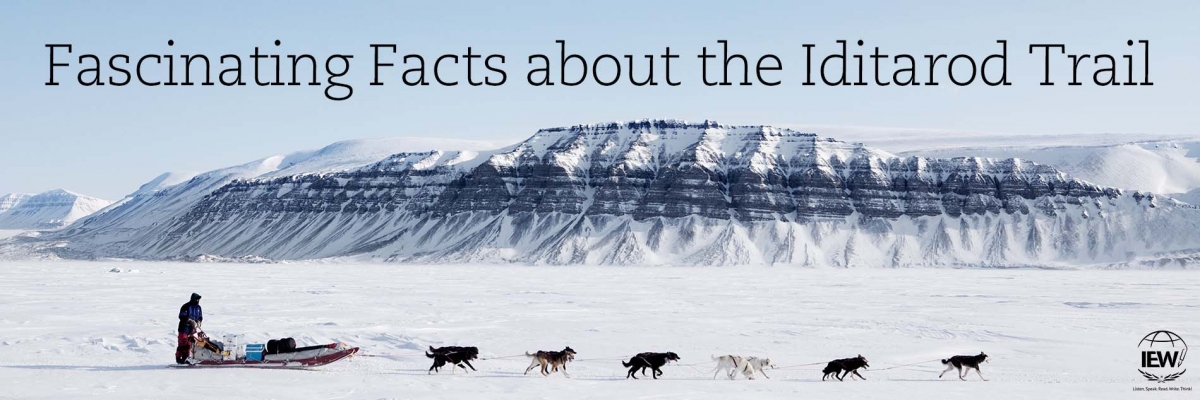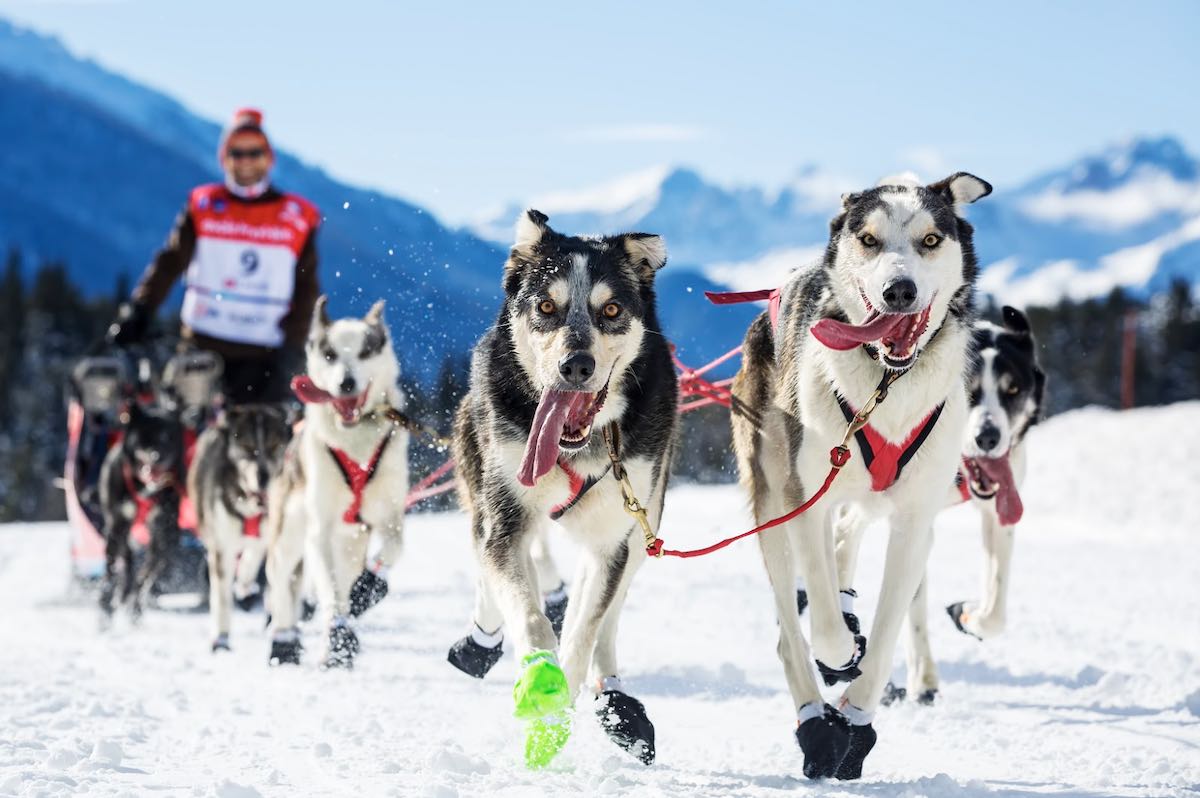
One of Andrew Pudewa’s Structure and Style for Students high school students was Andrew Vasher. He also joined the IEW team as a junior, supporting IEW’s marketing team. One of his goals, in his own words, is to “learn everything he can contain.” Recently Andrew took some time to research the Iditarod Trail and learned about the trail’s history and its current iteration as a thrilling sled dog race across the frozen wilds of Alaska. One of the fruits of his labors is this fascinating blog post in which he shares some of the knowledge that he learned. We are grateful to him for helping us all to learn a little bit about this fascinating trail. Continue reading this post to discover some of what he uncovered.

On March 3, 2020, more than fifty mushers along with their sled teams will travel across the Alaskan wilderness and risk life and limb for a chance to win the Iditarod Trail race. While you likely have heard of the dogs Balto and Togo, who led the sled teams that delivered livesaving serum to the stricken town of Nome, Alaska, the Iditarod has plenty of other history and facts to offer. One thing that is abundantly clear is that the Iditarod Trail has a rich history, one that is still being written to this day.
The history of the Iditarod Trail traces a long and winding path, starting with Alaska’s Gold Rush Era. This iconic trail became the backbone of the Gold Rush, allowing mail, supplies, and transport across the Alaskan wilderness. In 1925 the trail made history again when doctors in Nome found symptoms of a dire, dismal, deadly infection: diphtheria. Twenty mushers volunteered for the almost suicidal mission to carry lifesaving medicine to the stricken town. Eventually, this race would become known as the “Great Race of Mercy.”
Two mushers stood out in the situation—Leonhard Seppala and his experienced veteran lead dog, twelve-year-old Togo, and Gunnar Kaasen with his youngster of a lead dog, three-year-old Balto. Although many people and dogs had contributed to getting the serum to the town of Nome, Togo took the most perilous route. The young dog, Balto, who finished the final leg of the trail, became a symbol of perseverance and hope.
The rumbling of engines signaled the end of utilizing sled dogs. Airplanes started to replace mail transport, but the postal service still relied on dogs to reach the small towns tucked deep in the wilderness. The advent of steam locomotive trains changed transportation permanently. Eventually snowmobiles swept across Alaska, replacing sledding as the primary way to transport goods, supplies, and people. However, there were still some who stuck to the roots of mushing. In 1964 Dorothy G. Page got the idea of a race because she was intrigued that mushers and their dogs could travel places that snowmobiles could not and wanted people to not forget about the mushers and their teams. Later on, Joe Redington, with the inspiration of Page’s idea, founded a race that would span the one thousand miles that comprised the Iditarod Trail.
What is it like to run the Iditarod? Icy winds sheer across your face as you mush through the snowy landscape. The crunch of snow under your feet is the only noise you hear for hours on end. As you skid on top of frozen lakes, you scan the horizon for the trail. A desolate terrain surrounds you for hundreds of miles. Your lungs are heavy. Your bones ache. You are exhausted. One night you sleep relatively comfortably in a wooden cabin. The next night you may find yourself sleeping on the hard, frozen ground.
Participating in the race requires a list of necessities and a viable strategy. Mushers need an arctic parka, heavy sleeping bag, ax, snowshoes, food, and boots. Without these, the safety of the dogs and the musher would be in grave jeopardy. Ever-changing, the trail behaves almost like a living being. Because of this the mushers must have a solid strategy. While the mushers are on a journey to Nome, they are required to stop for a twenty-four hour rest period. Most strategy differences are found in their respective use of that twenty-four hour period. How hard they push their dogs, whether they decide to risk going through a storm or rest and avoid it are a few of the potential considerations they must weigh.
There are a myriad of steps that the mushers and the staff of the Iditarod Trail race must take to prepare for and complete the race safely. Raising money is a must in the off-season, whether the funds be sourced by getting a job or through fundraising. Without cash, a musher could not go on the trail. To keep the mushers and dogs safe, the staff of the Iditarod Trail race must prepare and maintain their airplanes. If a dog or musher gets injured, they may need to transport the injured party to a town that can treat them. These careful preparations ensure the participants are as safe as possible.
This tricky trail is full of trials and tribulations, both for the mushers and their dogs. Without the medical assistance of the veterinarians, the dogs’ mortality rates would skyrocket. The injuries that a dog could encounter could include torn nails, cut pads from ice and debris, and torn ligaments, to name just a few. When a dog is unable to pull the sled, a plane will fly the animal back to safety. When a dog is ill or does not have enough fluids, veterinarians provide help, supplying supplements and medications or liquids, which improve the animal’s health drastically. Quietly the veterinarians assist in the background; without them, the race could not happen.
Historically the Iditarod Trail has been the backbone of the age of travel and transport in Alaska. With the help of Dorothy G. Page and Joe Redington, the trail was revitalized in the modern era, giving it new value and life. Mushing along the trails, the mushers must keep themselves and their dogs safe. If their dogs do get harmed, there is help along the trail. The veterinarians assist the dogs with various needs, and if a dog needs to get off the path to Nome, a plane will escort it to a better location to heal. Having become a National Historic Trail, the Iditarod will always be a part of Alaskan history.
Websites Consulted for This Post
"History – Iditarod." Iditarod Insider, www.iditarod.com/about/history/.
"Togo (U.S. National Park Service)." National Parks Service, U.S. Department of the Interior, www.nps.gov/people/togo.htm.
"Returned Dog Care – Iditarod." Iditarod Insider, www.iditarod.com/about/veterinary-center/dropped-dog-care/.
"Iditarod." Alaska Centers, 18 Dec. 2019, www.alaskacenters.gov/explore/culture/dog-mushing/iditarod.
Akc. "The Real Story of Amblin's Balto." American Kennel Club, American Kennel Club,
24 Oct. 2017, www.akc.org/expert-advice/lifestyle/balto/.
“24-Hour Rest and Time Differential.” Iditarod, iditarod.com/edu/24-hour-rest-and-time-differential/.
The history of the Iditarod is truly fascinating. We hope you will share this post with your students. And if you like, you can expand their learning a little more by inviting them to write a Unit 5 composition inspired by this blog post that features an image captured from the perspective of a musher. Perhaps your students will imagine themselves as that musher making his or her intrepid way across the frigid Alaskan wilderness.
